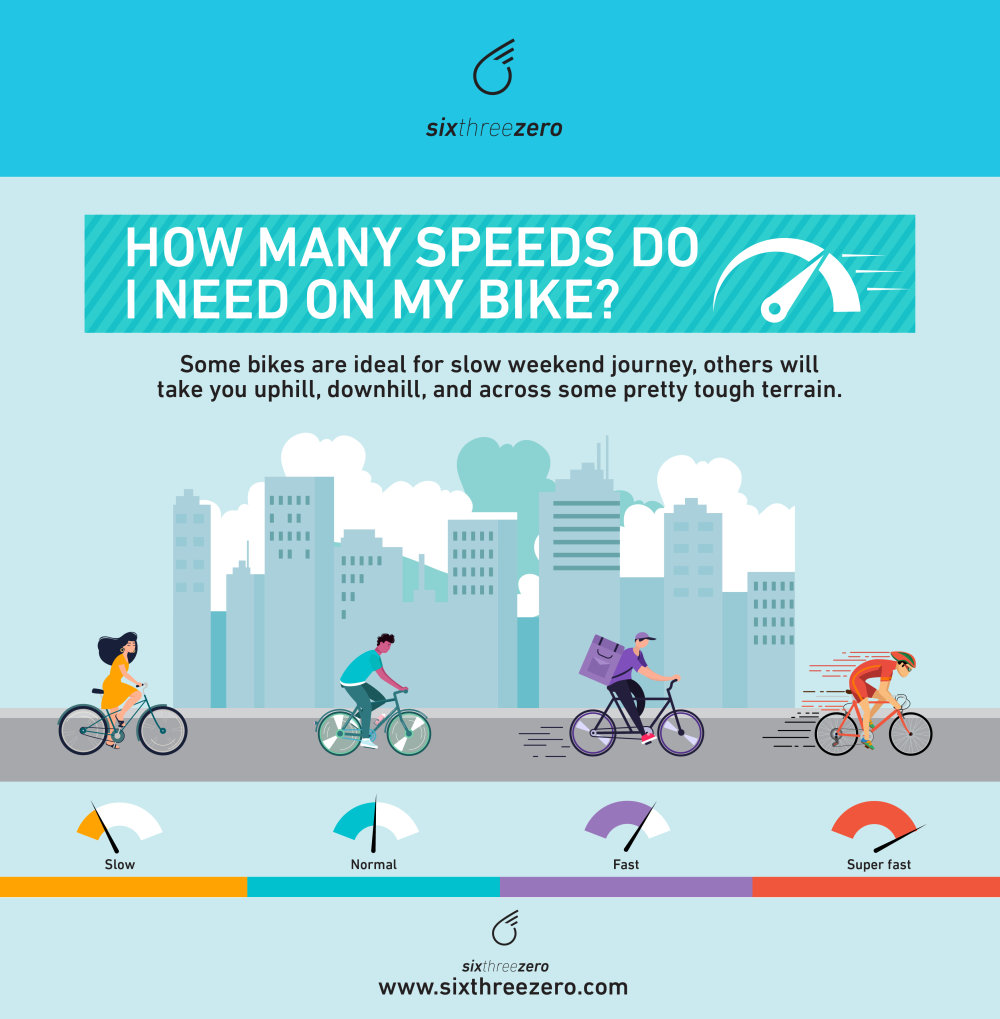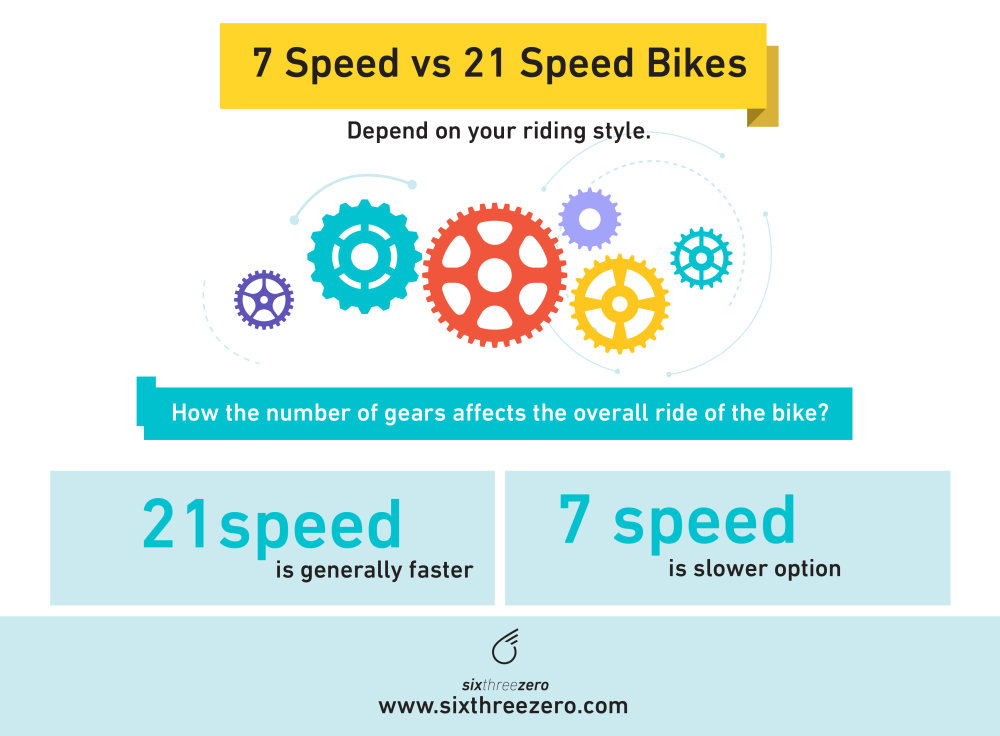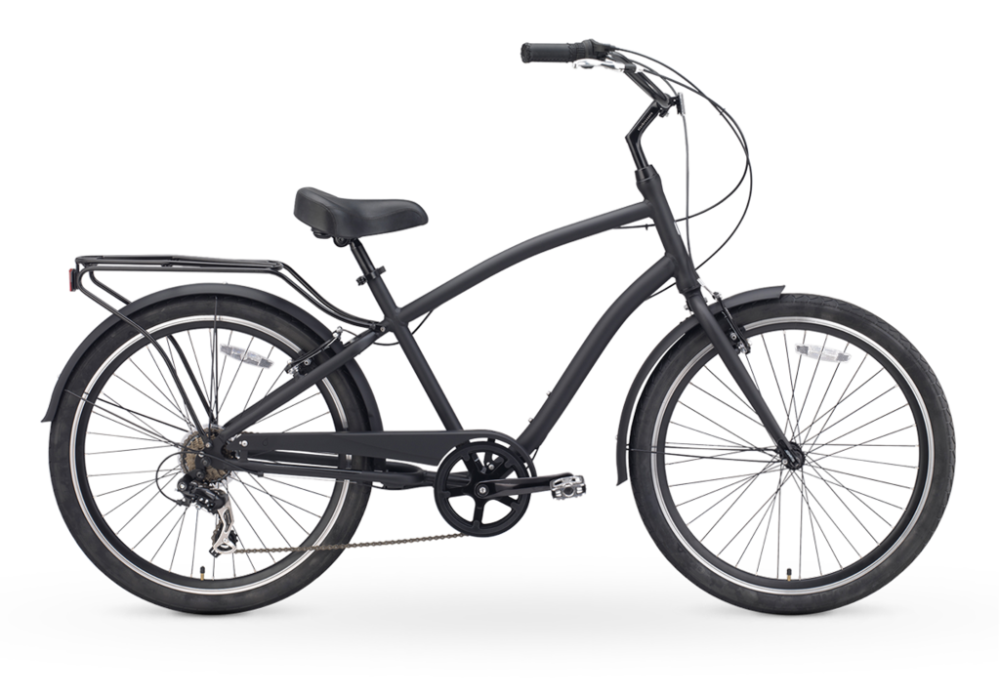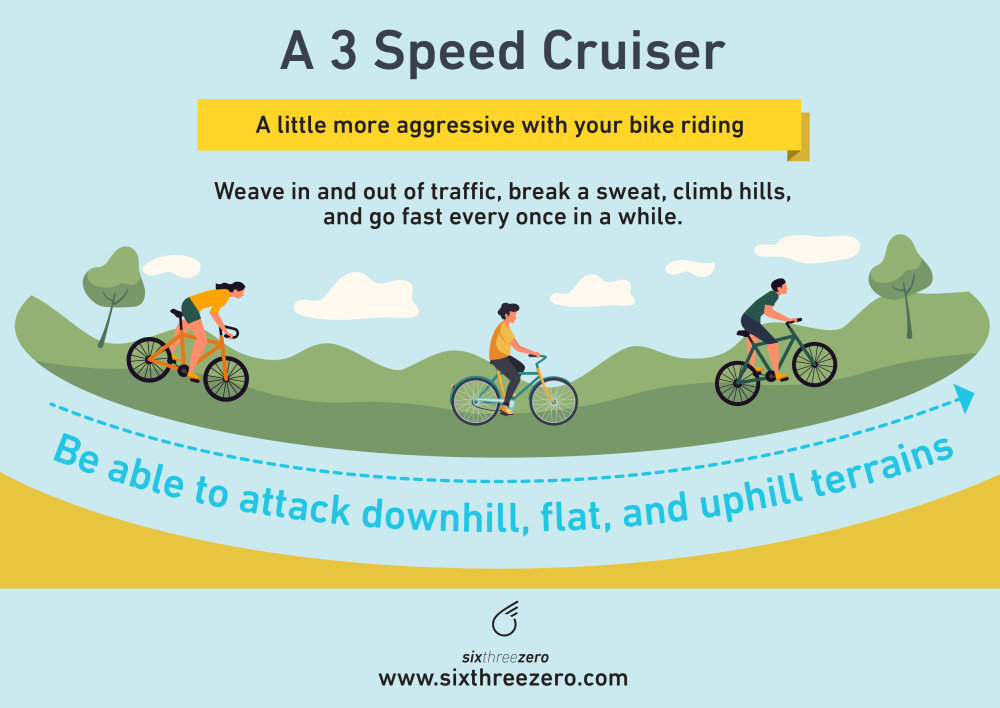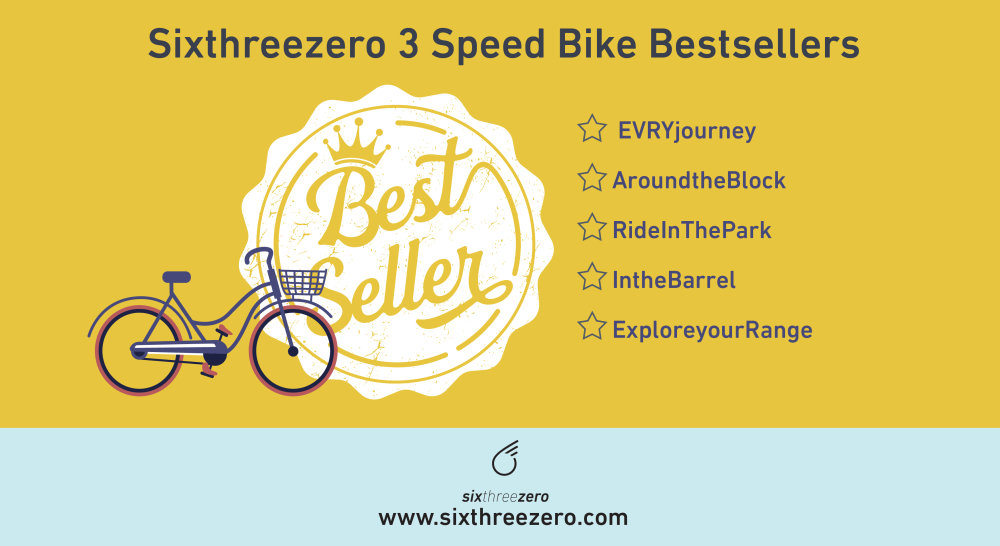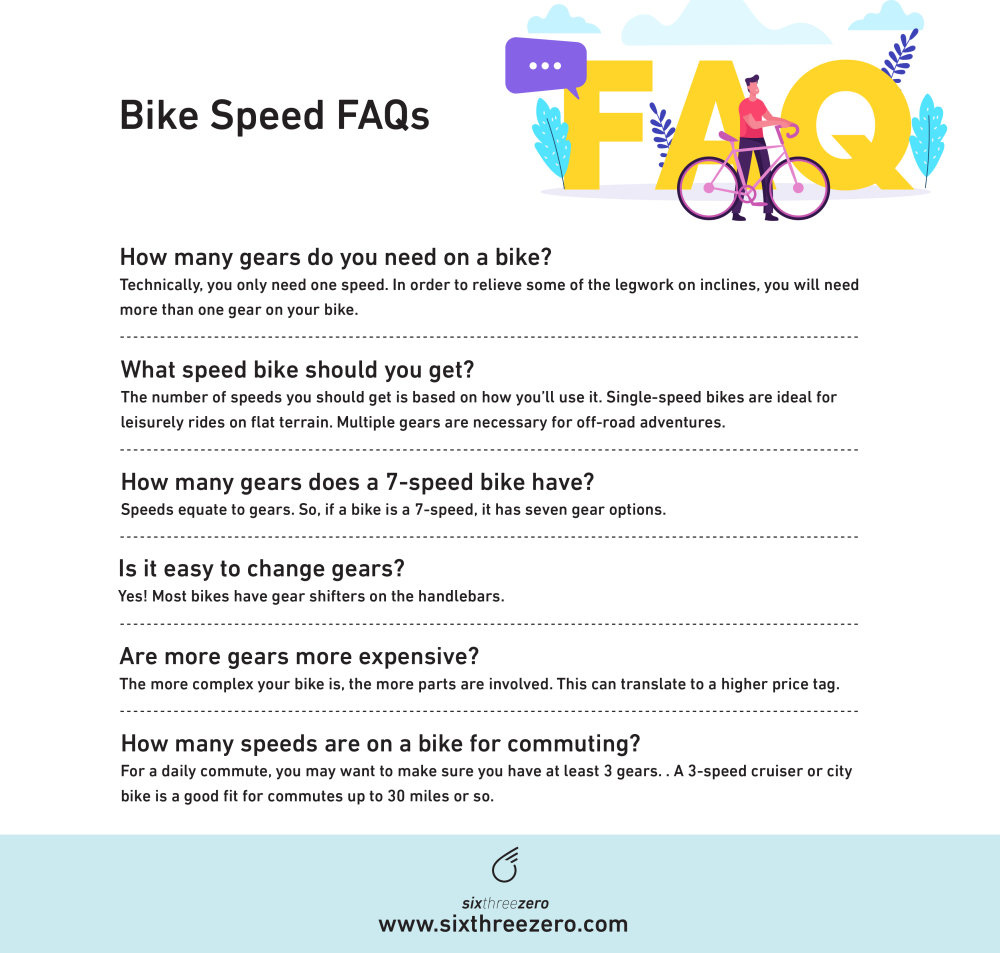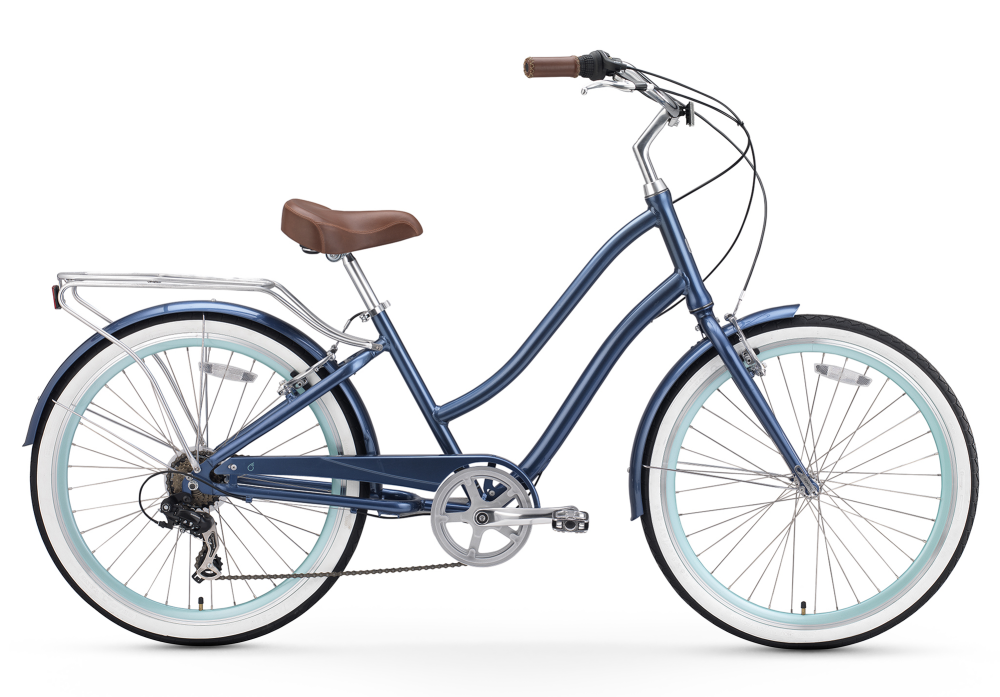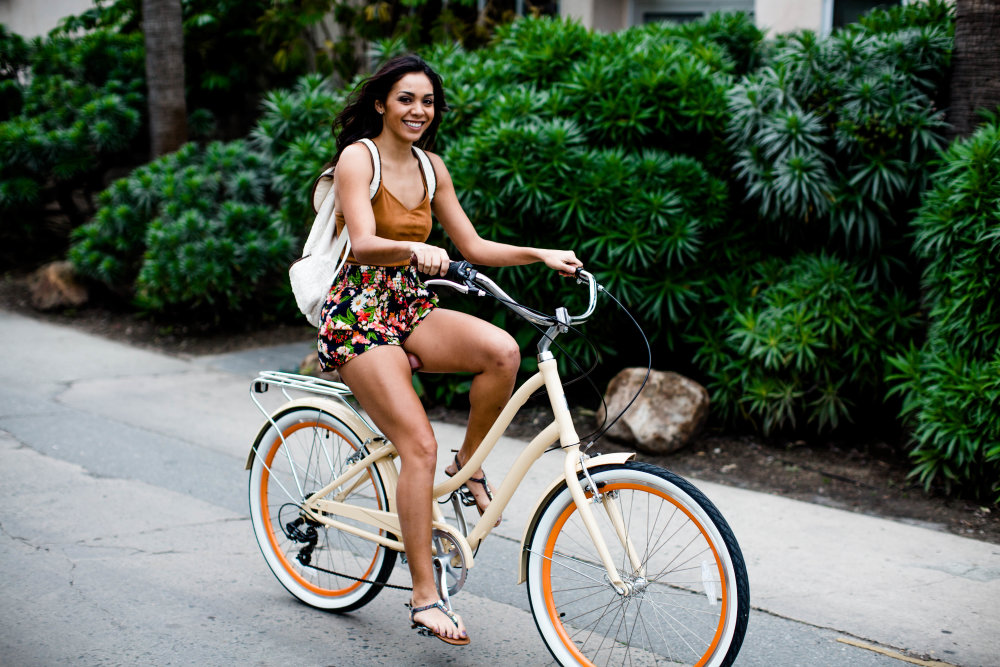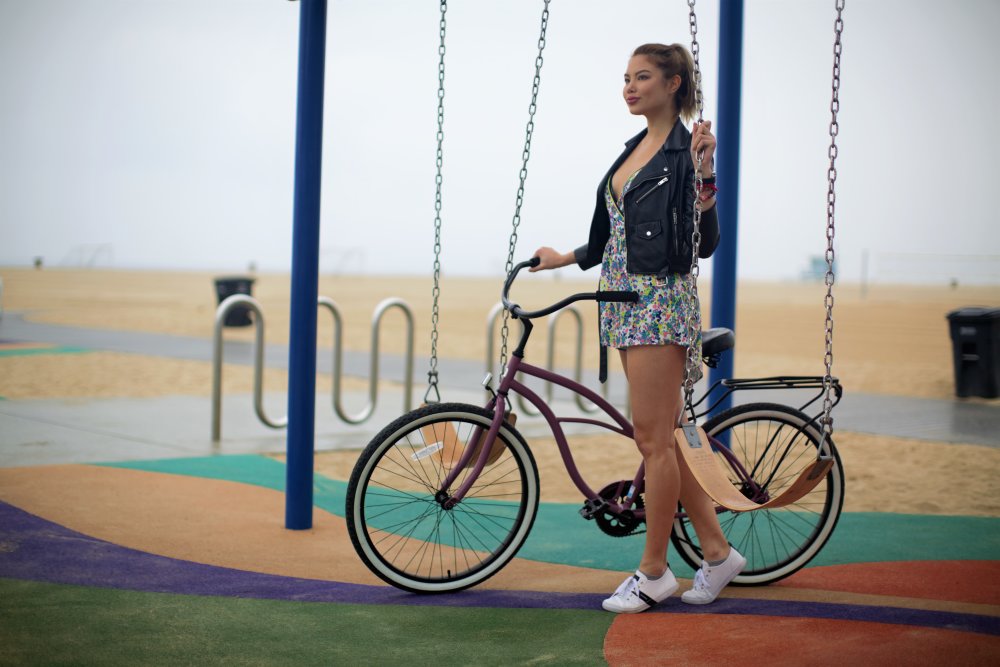E-Bikes & Bikes Customised to You
The question of how many speeds you need on your bike can be a complicated one—or a very easy one—depending on how clearly you know what you need from your bike. Determining the optimal number of speeds for a bicycle involves a nuanced consideration of various factors, including the rider's skill level, terrain preferences, fitness goals, and intended use of the bike. The number of speeds, often referred to as gears, significantly impacts the bike's versatility and performance across different environments.Some bikes are ideal for slow weekend journeys to the farmers market or along a lake bike path. Others will take you uphill, downhill, and across some pretty tough terrain.
To delve into this multifaceted topic, let's explore the key aspects that influence the decision on how many speeds one needs on their bike.
Firstly, it's essential to understand the basics of bicycle gears and how they function. Gears on a bike are achieved through the combination of multiple chainrings at the front, near the pedals, and a cassette at the rear wheel. The interaction between these components allows cyclists to vary the resistance and optimize their pedaling efficiency in different situations. The number of gears is determined by counting the total combinations of chainrings and cassette cogs.
Consideration must also be given to the maintenance aspect. Bikes with more gears generally require more attention to keep the drivetrain in optimal condition. Regular cleaning, lubrication, and occasional adjustments are crucial to ensure smooth shifting and prevent premature wear on components. Riders who prioritize low maintenance may lean towards simpler drivetrain setups with fewer gears.
The question of how many speeds one needs on their bike is subjective and depends on a myriad of factors. It involves finding the right balance between simplicity and versatility based on individual preferences, riding conditions, and fitness goals. The evolving landscape of bicycle technology continues to offer diverse options, allowing riders to tailor their gear systems to match their unique riding styles and preferences. Ultimately, the perfect number of speeds on a bike is the one that enhances the rider's enjoyment, efficiency, and overall cycling experience. In addition to the considerations mentioned above, another crucial factor in determining the appropriate number of speeds on a bike is the local topography and the predominant terrain where the cyclist plans to ride. Cyclists residing in predominantly flat regions may find that a bike with fewer gears suffices for their needs, as the necessity for frequent gear changes to tackle steep inclines is minimized. On the other hand, individuals living in areas with varying elevations or hilly landscapes might benefit from a bike with more gears to ensure optimal power delivery and efficiency across different gradients.
Furthermore, the type of cycling activities one engages in plays a pivotal role in the decision-making process. Commuters who navigate city streets with frequent stops and starts may find a bike with an internal hub or a limited number of gears advantageous, as these systems often require less maintenance and provide sufficient versatility for urban environments. Conversely, cyclists participating in competitive road races or long-distance touring may lean towards bikes with a higher number of gears to accommodate a diverse range of speeds and terrains.
If you already know you want to stick to your neighborhood, a single-speed may be all you need. When you’re on the adventurous side, you should seek out a multi-speed bike for sale. From single speed bikes, to 3 speed cruisers, to multi speed beach cruisers, sixthreezero has them all. You can even customize your ride with upgraded tires and a frame painted in your favorite color. Let’s take a look at what you can gain from bikes with single, 3, or multiple gears – and why you should decide how you’ll use your bicycle before you seal the deal.
Bike Speeds
Bike speeds refer to the number of gear ratios a bicycle has, determining how easily it can navigate different terrains. There are several types of bike speeds based on the gearing system:
Single-Speed: Single-speed bikes, also known as fixed-gear bikes, have only one gear ratio, which means that the pedals move in direct relation to the wheel rotation. This simplicity makes them low-maintenance and easy to use. They are often preferred by urban cyclists for their straightforward design and mechanical reliability. These bikes are well-suited for flat terrain, such as city streets and bike paths, where the lack of multiple gears is not a hindrance. The single gear ratio provides a consistent and efficient riding experience on such surfaces. Additionally, they are popular among casual riders who appreciate the straightforward nature of single-speed bikes. Due to their minimalistic design and lack of complex components, single-speed bikes are relatively affordable and easy to maintain. They are also lightweight compared to multi-speed bikes, making them easier to maneuver and transport. While single-speed bikes may not be ideal for hilly or varied terrain, they are a practical choice for riders who prioritize simplicity, low maintenance, and a laid-back riding experience.
3-Speed Bikes: A 3-speed gearing system on a bike means that there are three different gear ratios available to the rider. This allows for versatility when riding on varied terrain, as it offers the option of low, medium, and high gears. The low gear is useful for climbing steep hills or riding against strong winds, providing easier pedaling at a slower speed. The medium gear is suitable for flat or gently sloping terrain, offering a balance between speed and effort. The high gear is ideal for downhill sections or when riding at a fast pace on flat ground, allowing for efficient pedaling at a higher speed. Overall, the 3-speed gearing system provides flexibility and adaptability to different riding conditions.
7-Speed Bikes: A 7-speed configuration on a bike means that there are seven different gear ratios available to the rider, offering a broader range for tackling different landscapes. This setup is suitable for riders encountering both flat and hilly terrain, as it provides a variety of gear options to accommodate varying inclines and riding conditions. The multiple gear ratios allow for easier pedaling on uphill sections and provide the ability to maintain speed and efficiency on flat terrain. Overall, bikes with a 7-speed configuration offer versatility and adaptability to a wide range of riding environments.
21-Speed Bikes: Bikes with a 21-speed configuration offer an extensive range of gear ratios, making them suitable for various terrains, including steep inclines. This configuration typically features three front chainrings and seven rear cassette cogs. The three front chainrings provide options for different gear ratios, while the seven rear cassette cogs further expand the range of available gears. This allows riders to easily adjust their gear selection to match the terrain and their pedaling preferences. The wide range of gear ratios makes bikes with a 21-speed configuration versatile and well-suited for tackling a variety of landscapes, from flat roads to challenging uphill climbs.
24-Speed Bikes: Similar to 21-speed bikes, 24-speed bikes provide even more gear ratios, often achieved through a combination of three front chainrings and eight rear cassette cogs. This setup offers enhanced adaptability for diverse riding conditions, as it allows for finer adjustments in gear selection to match the terrain and riding preferences. The additional gear ratios provided by the 24-speed configuration offer riders a wider range of options, making it easier to find the optimal gear for different inclines, speeds, and riding situations. This increased flexibility makes 24-speed bikes well-suited for riders who encounter a variety of terrains and want the ability to fine-tune their gear selection for maximum comfort and efficiency.
27-Speed Bikes: Bikes with a 27-speed configuration are equipped with three front chainrings and nine rear cassette cogs, offering a total of 27 gear combinations. This setup provides an extensive range of gear ratios, allowing riders to achieve optimal performance on a wide variety of terrains. The three front chainrings enable the rider to make larger changes in gear ratio, while the nine rear cassette cogs provide finer adjustments, resulting in smooth transitions between gears. This wide range of gear options is especially beneficial for riders who encounter diverse terrain types, including steep inclines, flat roads, and rough off-road trails. Whether tackling challenging uphill climbs or cruising at high speeds on flat surfaces, the 27-speed configuration offers the versatility and adaptability needed for an enjoyable and efficient riding experience.
Mountain Bikes with 30+ Speeds: High-performance mountain bikes with 30 or more speeds feature multiple front chainrings and a large number of rear cassette cogs, allowing for precise gear adjustments during challenging off-road rides. The multiple front chainrings and extensive rear cassette cogs provide a wide range of gear ratios, giving riders the ability to make precise adjustments to their gear selection based on the steepness of the terrain and the intensity of the ride. This level of gear customization is particularly valuable during off-road rides, where riders encounter unpredictable inclines, descents, and obstacles. The high number of speeds and gear options make these mountain bikes ideal for riders who seek maximum performance and adaptability in demanding off-road conditions.
Fixed Gear (Fixie) Bikes: Fixed gear bikes have a single gear ratio and lack a freewheel mechanism, meaning the pedals move with the wheel's rotation. This design requires constant pedaling, as the rider cannot coast or freewheel. Fixed gear bikes are often used for urban commuting and track cycling due to their simplicity and low maintenance requirements. The direct connection between the rider and the bike's movement provides a unique riding experience and allows for precise control over speed and cadence. Fixed gear bikes are popular among urban cyclists for their maneuverability and responsiveness, while track cyclists appreciate their direct power transfer and connection to the bike.
Electric Bikes (e-Bikes) with Multiple Speeds: Electric bikes with multiple speeds are designed to provide riders with the option of using electric assistance in combination with traditional gears. This means that riders can choose to manually pedal the bike or rely on the electric motor to propel them forward. These bikes typically offer various modes, such as pedal-assist and throttle-assist, giving riders the flexibility to select the level of electric assistance they prefer. The pedal-assist mode provides support to the rider's pedaling efforts, while the throttle-assist mode allows riders to control the speed of the bike using a throttle mechanism. This combination of electric and manual propulsion makes multi-speed electric bikes versatile and suitable for a wide range of riding preferences and terrains.
7 Speed vs 21 Speed Bikes
When comparing 7-speed and 21-speed bikes, it's important to consider the differences in terms of gear options and how they affect the riding experience.
7-Speed Bike:
- A 7-speed bike typically has a simpler gear system with a limited range of gear options.
- It's well-suited for casual riding, city commuting, and relatively flat terrains.
- The limited gear range may make it less suitable for steep inclines or varied terrain.
21-Speed Bike:
- A 21-speed bike offers a wider range of gear options, making it more versatile for various terrains and riding conditions.
- With three front chainrings and seven rear cogs, a 21-speed bike provides more precise gearing for uphill climbs, downhill descents, and varying terrain.
- It's ideal for riders who tackle diverse landscapes, including hills and rough trails.
The choice between a 7-speed and 21-speed bike depends on the rider's specific needs and the type of terrain they plan to navigate. For casual urban riding, a 7-speed bike may suffice, while more adventurous riders or those facing diverse terrains may benefit from the wider gear range of a 21-speed bike.
When considering the number of gears you need on a bike, most people will settle on either a 7-speed or a 21-speed. However, which bike you choose will depend on several factors, including your riding style.
In terms of how the number of gears affects the overall ride of the bike, a 21-speed is generally faster with smoother transitions and pedaling. The 7-speed is adequate for most riders, which is why many people choose the slower option. Because there are fewer gears and the bike's build is less complicated, 7-speed cycles tend to be cheaper than 21-speed options. However, before deciding on the more affordable model, consider your riding style.
Do you enjoy exploring the trails or racing over rough terrain? Or, would you rather take a leisurely ride through the city or on a morning commute? If you prefer rougher terrain and shorter rides, a 7-speed is an excellent choice; the bike can take the abuse. Alternatively, if you want a commuter bike, speed and comfort are likely high-priority attributes, so a 21-speed is best. As you weigh the pros and cons of the 7-speed and 21-speed, consider your own preferences. While some professional or avid cyclists might argue the merits of a 21-speed over a 7-speed, what ultimately matters is how you use the bike and how comfortable you are while doing it.
A Single Speed Bike
For novice riders or those using bikes primarily for commuting on flat terrain, a single-speed or fixed-gear bike might be a suitable choice. A single speed bike is just what it sounds like: two-wheelers constructed with just one speed, meaning you never have to switch gears. Pedal forward, and your bike goes forward; pedal backward and it stops. A single speed bike is perfect for anyone who simply wants to take their baby out for a spin for fresh air, a little exercise or both, and preferably on flat terrain. A single speed bike is uncomplicated, which makes it easy to ride. However, they are also slow, so if speed or climbing hills is your thing, then perhaps you should consider a different type of bike since you will develop a substantial sweat riding either. Single-speed bikes, with just one gear ratio, are known for their simplicity, low maintenance, and ease of use. They are particularly popular among urban commuters who appreciate the straightforward design and the absence of gear shifting complexities. Fixed-gear bikes, on the other hand, lack a freewheel mechanism, meaning the pedals move in sync with the wheel. While these bikes offer a unique riding experience, they require a certain level of skill and control. Here you can check out the whole lineup of sixthreezero single speed bikes.
Single speed bikes offer several benefits, including:
Simplicity: Single seed bikes are uncomplicated and easy to use, making them ideal for casual riders and beginners.p
Low Maintenance: With fewer moving parts, single speed bikes require less maintenance and are easier to care for.
Lightweight: Single speed bikes are often lighter than multi-speed bikes, making them easier to maneuver and transport.
Affordability: Due to their simplicity, single speed bikes are often more affordable than multi-speed bikes.
Fitness: Riding a single speed bike can provide a good workout, as it requires constant pedaling and engagement of leg muscles.
Connection to the Road: Single speed bikes offer a more direct connection to the road, providing a unique riding experience
These benefits make single speed bikes a popular choice for riders looking for a straightforward and enjoyable cycling experience.
A Multi Speed Beach Cruiser
Want to be able to traverse any terrain, dart in and out of any situation, go fast, climb hills and have a bike that answers any of your commands while still being comfortable and easy to ride? Well, then that’s easy: a multi speed beach cruiser is the best choice for you. A multi-speed beach cruiser is a type of bicycle designed for leisurely rides along the beach or around town. Unlike traditional single-speed beach cruisers, multi-speed beach cruisers offer the flexibility of changing gears to accommodate different terrains and inclines. These bikes typically feature a comfortable, upright riding position, wide handlebars, and a cushioned saddle for a relaxed and enjoyable riding experience. The addition of multiple gears allows riders to tackle hills or headwinds more easily, making the bike suitable for a wider range of riding conditions. Multi-speed beach cruisers often come with features such as a durable steel frame, coaster brakes or hand brakes, and a stylish, retro-inspired design. They are popular among casual riders who value comfort, style, and the ability to handle varying terrain.
A multi-speed beach cruiser offers several benefits, including:
Versatility: Multi-speed beach cruisers allow riders to adjust their speed and gear ratio to suit different terrains, such as flat roads, hills, and inclines. This versatility makes them suitable for a variety of riding conditions.
Comfort: With multiple gears, riders can choose a comfortable pedaling cadence, reducing strain and fatigue during longer rides. This can make the riding experience more enjoyable and less physically taxing.
Improved Performance: Multi-speed beach cruisers provide better performance on challenging terrains, allowing riders to maintain a consistent speed and pedal with less effort, especially when riding uphill or against strong headwinds.
Enhanced Riding Experience: Multi-speed beach cruisers offer a more dynamic and engaging riding experience, as riders have the option to shift gears and adapt to changing conditions, resulting in a more satisfying and enjoyable ride overall.
These benefits make multi-speed beach cruisers a popular choice for riders seeking comfort, versatility, and improved performance in various riding environments.
With as many as seven speeds, your stocked two-wheeler can offer the precise speed for any situation, meaning your pedaling will be as easy as it can be while still generating the speed and movement you desire. Take a tour of all of sixthreezero’s multi speed beach cruisers.
Sixthreezero 3 Speed Bike Bestsellers
If you are more interested in cruising around town, you might not need either the 7-speed or the 21-speed. In fact, a 3-speed might be more than enough for you and your riding style.
A 3-speed bike often comes as a comfort or cruiser bike. The multiple gears allow for easy riding and decent speed, all while maintaining a relaxed riding experience. Some of the best 3-speed bikes at Sixthreezero include:
Best Selling Multi Speed Bike at Sixthreezero
If you are looking for the bestselling multi-speed bike at Sixthreezero, look no further than the Paven’Trail, a 21-speed beauty with adjustable suspension and comfort-first engineering. The bike has a lightweight, ergonomic frame with durable hybrid tires. While the bike was designed with experienced riders in mind, it is not intended for competitive riding or aggressive off-roading. Instead, this bike is ideal for everyday rides.
Are you ready to choose your next bicycle? If so, reach out to a local bike shop and talk to one of the experts on staff to find a bike with the right fit and personality for your style.
Bike Speed FAQs
Nailing down the number of speeds you need takes some time and consideration. How far do you plan to travel? Will there be hills? Some new riders may be uncomfortable with multiple gears, but still need them to travel over their desired terrain. Here are some things to consider as you decide between a simple single-speed and a more complicated 21-speed – and everything in between.
- How many gears do you need on a bike?
Technically, you only need one speed. Hence, the single-speed bike. Don’t assume that just because a bike only has one speed that it can’t get you where you need to go. On the other hand, in order to relieve some of the legwork on inclines, you will need more than one gear on your bike.
- What speed bike should you get?
The number of speeds you should get is based on how you’ll use it. As we mentioned above, single-speed bikes are ideal for people who want to go on leisurely rides on flat terrain. If you are going to be cruising around the neighborhood or going on casual rides in the park, stick with a single speed. On the other hand, multiple gears are necessary for off-road adventures.
As you go uphill and struggle to make progress, having multiple gears allows you to downshift and make the trek easier. On the way down, if you pedal and feel no resistance, you can upshift to a higher gear so you don’t lose control.
- How many gears does a 7-speed bike have?
Speeds equate to gears. So, if a bike is a 7-speed, it has seven gear options.
- Is it easy to change gears?
Yes! Most bikes have gear shifters on the handlebars. Thumb shifters have a lever on each handlebar that you can move up or down as needed. Grip shifters allow you to change gears by twisting the shifter forward or backward. Some bikes also let you control front gears and back gears on different sides of the handlebars (i.e. front gears using the right hand and back gears using the left hand).
- Are more gears more expensive?
The more complex your bike is, the more parts are involved with keeping it running smoothly and safely. This can translate to a higher price tag. At the same time, your multi-gear bike lets you explore more types of terrain and destinations. Think of your gear investment as an investment in your future experiences.
- How many speeds are on a bike for commuting?
For a daily commute, you may want to make sure you have at least 3 gears. Unless you’re on entirely flat terrain the entire way, you’ll want the option to shift up and down. You’re going to work, after all, you don’t want to show up sweatier than necessary. A 3-speed cruiser or city bike is a good fit for commutes up to 30 miles or so.
- What is the ideal speed for biking?
The ideal biking speed varies depending on factors such as terrain, rider's fitness level, and the type of bike. However, a comfortable speed for most recreational cyclists ranges from 10 to 15 miles per hour on flat terrain.
- How can I increase my biking speed?
To increase biking speed, focus on improving your fitness level, optimizing your bike's gearing, maintaining proper bike maintenance, and practicing efficient pedaling techniques.
- What are the benefits of biking at higher speeds?
Biking at higher speeds can provide a more intense cardiovascular workout, improve overall fitness, and cover longer distances in a shorter amount of time.
- Are there speed limits for biking?
Speed limits for biking vary by location. In general, cyclists are expected to follow the same speed limits as motor vehicles on roads. However, specific speed limits for cyclists may be posted in certain areas.
- What gear ratio is ideal for increasing speed?
A higher gear ratio, achieved by using larger chainrings and smaller rear cogs, can help increase speed on flat terrain and downhill sections. However, it may require more effort to pedal uphill.
- Is it safe to bike at high speeds?
Biking at high speeds can be safe if proper safety precautions are followed, such as wearing a helmet, using hand signals, obeying traffic laws, and maintaining control of the bike at all times.
- How does wind resistance affect biking speed?
Wind resistance can significantly impact biking speed, especially at higher speeds. Riding in a tucked position or using aerodynamic equipment can help reduce wind resistance and improve speed.
- What role does cadence play in biking speed?
Cadence, or the speed at which you pedal, plays a crucial role in biking speed. Maintaining an optimal cadence helps to generate power efficiently and sustain higher speeds for longer durations.
Which Bike Speeds Are Best For Climbing Hills?
Riding up hills on a bike can be tough, but picking the right gear makes it easy. So, here are certain bike speeds that you can use to climb up hills and get a better riding experience.
3-Speed Bike
Like the 1-speed Bike, a 3-speed Bike works well on flat grounds and gentle hills (Not Steep Hills). It has 3 gears but does not handle big hills well. Not only this, this bike has the lowest gear as well which makes it much easier to pedal.
7-Speed Bike
This is also a good speed for flat ground, but it holds some steep hills. Furthermore, it is also a great all-around bike. 7-Speed Bike has a low gear for going up hills. Not only this, it has a high gear for going fast as well. It is a perfect bike for riding around town, at the beach, or even in the park. We think the 7-speed bike is more useful than the 21-speed bike.
21-Speed Bike
A 21-Speed Bike is great for both flat ground and steep hills. Moreover, it can handle any hill you come across. This bike also has a low gear that makes it easy to go up steep hills and a high gear for fast riding. Hence, it is good for people with knee problems because it makes pedaling feel easy. In low gear, it feels like you are pedaling, but the bike moves. This 21-speed Bike is the “Fastest/Slowest” option.
Finding the right bike speeds for climbing hills makes your rides more enjoyable. Besides this, you must also try out different gears, pay attention to how you feel, and have fun as you ride!
How To Identify The Number Of Speeds On A Bike?
Knowing how to find out how many speeds your bike has can make your rides better. Moreover, it helps you pick the right gear for different paths and hills.
- Part Identification: Check the back of the bike where the gears are located. You should then look for the rear derailleur (which moves the chain) and the cassette (Which is the group of gears on the back wheel). Count how many individual cogs (Small Gears) are on the cassette.
- Count And Multiply: To find out how your bike speeds, you should multiply the number of chaining by the number of cogs on the back. For instance, if your bike has 2 chains in the front and 8 cogs in the back, you would do 2*8, which equals 16 speeds.
- Single Chainring & Cog: If your bike has only one chainring & cog on the back, it is a single-speed bike. This means it has one gear, further making it simple to use and easy to maintain. Single-speed bikes are for flat areas or city riding.
By using these simple tips, you can figure out the bike speeds. Moreover, it will also make your rides smoother and more fun. So, enjoy cycling and every ride you take.
Thanks to sixthreezero’s outstanding cross-section of bike styles, as well as its unique customizer, you can be certain that the bike you buy is the bike you need. It doesn’t matter if you go with a single-speed bike or one with more gears: you’ll be riding in style and comfort. Start browsing for a women’s single-speed bike or a men’s single-speed bike if you’re a leisurely biker who’s not out to break a sweat. Check out our 3- and 7-speed models so you have the option to explore more trails. It’s up to you. Just don’t forget to choose a new seat and frame before you check out, so you can make your new two-wheeler truly your own. Still have questions about bike gears? Contact sixthreezero right now to get help. We know a thing or two about bikes and we’re happy to share.
Fit

